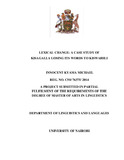| dc.description.abstract | This study presents a systematic investigation of the lexical change taking place in Kisagalla, through the loss of native Kisagalla words to Kiswahili. This was after informal interactions with some native speakers of Kisagalla showed that Kisagalla was abandoning its native words for Kiswahili words in ways that called for an organized study to find out why this was happening. Data was collected from native speakers of Kisagalla who were sampled using the stratified random sampling of willing respondents. The data collection instruments included Individual Language Use and Perception (ILUP) questionnaires for various age groups, interview guides for community opinion leaders and focused group discussions for the organized community groups. The first chapter presents a background to the study, its objectives, methodology, and the conceptual framework to be used for data analysis. Chapter two presents the analyses, findings, and discussions for the first two objectives. Under the first objective of the study, an inventory of two hundred and thirty seven (237) native Kisagalla words that have been lost was compiled as evidence of the lexical change under study. Under the second objective, these words were then grouped into word categories and semantic areas, with a view to identifying the word categories and semantic areas that were most affected by this lexical change. The study found out that nouns (N), and verbs (V) were the most (most precisely, the only) affected word categories, while the most affected semantic areas were those containing words referring to: body parts (semantic area 5), household items (semantic area 9), and socio-cultural vocabulary (semantic area 14). Using the Giles et al. (1977) Model of Language Shift and Language Vitality, the factors responsible for this lexical change from Kisagalla to Kiswahili were identified and classified under three broad clusters; social, demographic, and institutional support factors as shown in chapter three. Chapter four presents a summary of the discussions and some recommendations for further research. | en_US |



